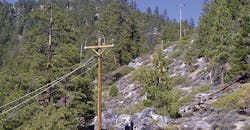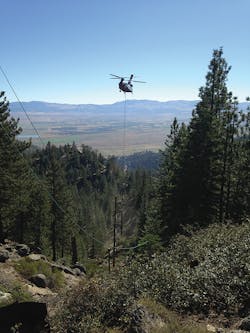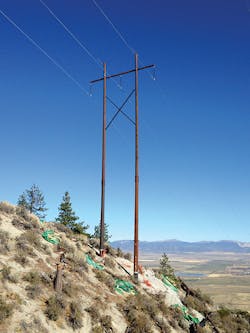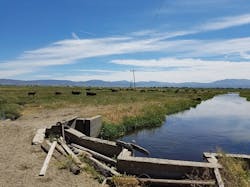NV Energy Rebuilds Power Line to Improve Reliability
In 1956, NV Energy (then Sierra Pacific Power Co.) constructed a new 60-kV transmission line from the town of Minden, Nevada, to Stateline, California, to serve the growing customer loads on the southeast shores of Lake Tahoe. Roughly 15 miles long, the line traverses through 5 miles of flat valley agricultural land before climbing more than 2700 ft to cross the Carson Range and drop back down into the Lake Tahoe basin. The original line design was typical for the day, consisting of single wood pole construction, porcelain insulators on wood crossarms and small 2/0 ACSR “Quail” conductor.
The line served its purpose well for more than 60 years, but by the fall of 2012, it had become clear that routine maintenance was no longer feasible to keep the line in reliable service. Structures in the Carson Valley were subjected to flooding and were impossible to access with vehicles for many months of the year. Numerous poles were leaning due to the poor soil conditions and high wind loads. On the mountain slopes, poles were damaged by dry rot, woodpeckers, fires and falling trees. Construction access and maintenance roads were heavily overgrown with brush or were nonexistent. Line crews had to walk in to most sites, but many of the poles were no longer safe to climb.
To bring the line up to a new standard of reliability, a complete rebuild of about 6 miles of the line was in order. Design and permitting began in the fall of 2012. The project was broken into two segments, and each required a fresh look and out- of-the-box thinking.
Taking On the Mountain
From the base of the western edge of Carson Valley to the top of Kingsbury Summit, 50 individual single-pole structures carried 3 miles of the original 60-kV line through steep mountainous terrain and deep canyons. With short spans of only 200 ft to 400 ft long, many of the poles were in hard-to-reach locations near the bottom of ravines.
NV Energy identified a number of goals during the redesign process. The new line had to minimize environmental impacts, improve the line’s resistance to extreme weather and mountainous climate, and provide adequate capacity for future load growth. In addition, the steep slopes and limited vehicle access made it clear that helicopter construction would be the only feasible way to construct the new line and remove the old poles and tree cuttings.
The utility selected light-duty, direct-buried steel poles to carry the new segment of line to minimize helicopter lift loads. The steel structures also would resist forest fires, woodpeckers and pole rot. New weathering steel poles, which were provided by Sabre-FWT, were pre-assembled in a fly yard at the base of the mountain.
To take advantage of the rugged terrain, one-third of the line segment was changed to H-frame construction. This change allowed for significantly longer spans than the original design and eliminated the need for 18 single-pole structures.
The longest span now stretches more than 1800 ft. The new H-frames are in more accessible locations on peaks and ridge tops, and the longer, higher spans over canyons minimized tree-clearing requirements during construction. In addition, they will reduce the threat of future damage due to avalanches and falling trees.
Shield wire was added to the line to provide lightning protection on exposed peaks. The conductor was upgraded to 397.5 ACSR “Ibis” for increased capacity and ice loading capability. The new insulators are now polymer and are of sufficient length to meet raptor protection requirements.
Contract crews from Titan Electric began clearing the right-of-way and hand-digging pole holes in the summer of 2016. Heavy-lift helicopters flew new structures into place in the fall, and a light helicopter pulled the conductor and shield wires into the new structures in October. The new line segment was energized on November 15, just in time for the Heavenly Ski Resort to begin snow-making operations.
Crossing the Swamp
The second phase of this project took place in the Carson Valley, a wet oasis in the typically arid state of Nevada. Here, the 60-year-old line crosses the Carson River and farm and ranch lands with a water table less than 1 ft below the surface.
Ranchers in the area use flood irrigation to water their land during the spring and summer, contributing to swampy ground conditions. Over time, the wooden poles had rotted and lost their foundation rigidity. Some were leaning at up to a 15-degree angle, which compromised the transmission line. Leaning poles are common in the Carson Valley, and this phase of the project was seen as a testing ground for future remediation throughout the valley.
To provide a long-term solution to the poor soil conditions, NV Energy engineers researched various strategies and products that would address the soft soil and watery challenges in this area. They eventually teamed with a company called Helical Pier Systems (HPS).
Instead of using conventional drilling or excavating for pole holes, a helical pier is augured 30 ft into the ground to provide foundational support. The lower section of the pier consists of 6-inch-diameter steel pipe with a single-wrap auger plate. The upper section is a 10-ft-long hollow tube, 24 inches to 42 inches in diameter. When the entire assembly is set in the ground, new poles are then placed into the upper can, the can is backfilled with pea gravel and then capped with concrete to waterproof the can.
Facing a Tight Schedule
Because of local irrigation practices, the construction schedule in this segment of line was very short. The soils were too soft to travel on before September, but all work had to be completed and the line re-energized by November 15. The helical pier system made this project schedule possible. HPS provided the piers with short lead times, and all 56 piers were drilled into place in only seven days.
NV Energy transmission operations line crews were able to install and backfill the new poles in short order. By the end of October, the linemen had installed all of the wood pole structures and new conductor and shield wire on the 3.8-mile stretch through the Carson Valley.
The Carson Valley section of line originally consisted of 60 wood poles, but the stronger pole and anchoring system enabled the engineers to increase span length and reduce the number of structures to 54. This reduction of structures allowed the ranchers in this area to regain some of their land and better use it for agricultural needs.
After three and a half years of permitting and design, and five months of construction, the $5.9 million line rebuild project was successfully completed and energized, on time and within budget. The rebuilt line has numerous advantages over its predecessor, including stable foundations, resilient steel structures, lightning protection and raptor safety. With increased capacity and greatly improved reliability, the new line stands ready to serve NV Energy customers for another 60 years. ♦
Jim Lehan is a principal engineer of NV Energy’s electric delivery organization. He has been with the company for 31 years and is a professional engineer in Nevada and California.
Devon Kendall is an engineer in NV Energy’s transmission and civil engineering department. He has been with the company for two years.
About the Author
Jim Lehan
Principal Engineer
Jim Lehan is a principal engineer of NV Energy’s electric delivery organization. He has been with the company for 31 years and is a professional engineer in Nevada and California.
Devon Kendall
Engineer
Devon Kendall is an engineer in NV Energy’s transmission and civil engineering department. He has been with the company for two years.



